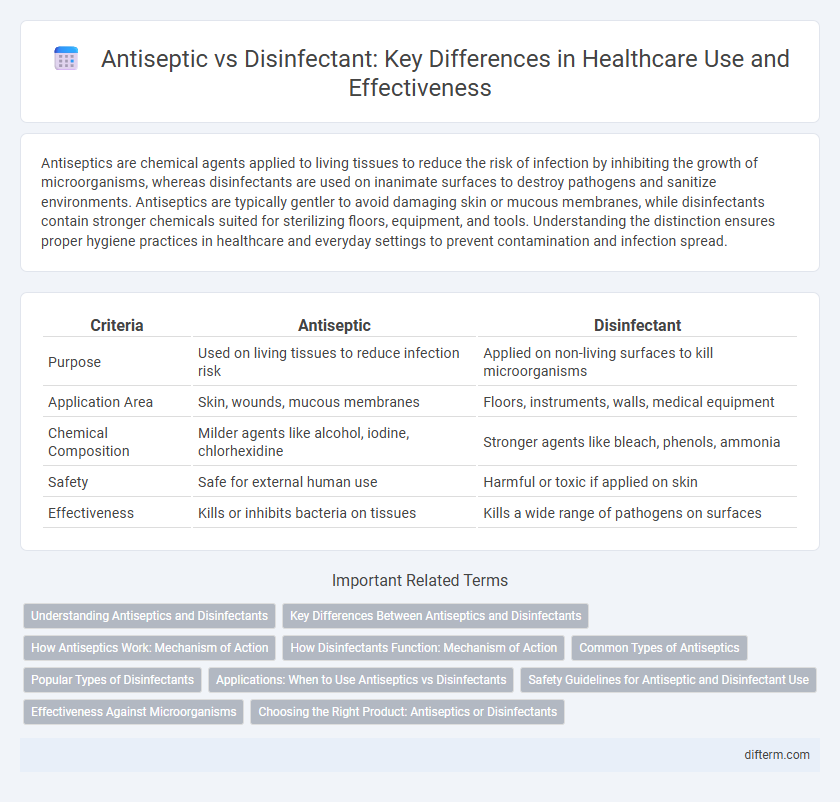Antiseptics are chemical agents applied to living tissues to reduce the risk of infection by inhibiting the growth of microorganisms, whereas disinfectants are used on inanimate surfaces to destroy pathogens and sanitize environments. Antiseptics are typically gentler to avoid damaging skin or mucous membranes, while disinfectants contain stronger chemicals suited for sterilizing floors, equipment, and tools. Understanding the distinction ensures proper hygiene practices in healthcare and everyday settings to prevent contamination and infection spread.
Table of Comparison
| Criteria | Antiseptic | Disinfectant |
|---|---|---|
| Purpose | Used on living tissues to reduce infection risk | Applied on non-living surfaces to kill microorganisms |
| Application Area | Skin, wounds, mucous membranes | Floors, instruments, walls, medical equipment |
| Chemical Composition | Milder agents like alcohol, iodine, chlorhexidine | Stronger agents like bleach, phenols, ammonia |
| Safety | Safe for external human use | Harmful or toxic if applied on skin |
| Effectiveness | Kills or inhibits bacteria on tissues | Kills a wide range of pathogens on surfaces |
Understanding Antiseptics and Disinfectants
Antiseptics are chemical agents applied to living tissues to reduce the risk of infection by inhibiting or killing microorganisms, while disinfectants are used on non-living surfaces to destroy pathogens and prevent cross-contamination. Common antiseptics include substances like alcohol, iodine, and hydrogen peroxide, which are safe for skin application. In contrast, disinfectants such as bleach, formaldehyde, and phenolic compounds are more potent and primarily employed in clinical and environmental cleaning settings.
Key Differences Between Antiseptics and Disinfectants
Antiseptics are substances applied to living tissues to inhibit the growth of microorganisms, while disinfectants are chemical agents used on non-living surfaces to destroy pathogens. Antiseptics are typically milder to avoid damaging skin or mucous membranes, whereas disinfectants contain stronger chemicals for more effective sterilization of objects and environments. The primary difference lies in their intended use: antiseptics ensure safety in medical procedures on patients, whereas disinfectants maintain hygiene in clinical and household settings.
How Antiseptics Work: Mechanism of Action
Antiseptics work by targeting the cell membranes and proteins of microorganisms, disrupting their structural integrity and metabolic functions to inhibit growth or kill the pathogens. Common antiseptic agents like alcohols, chlorhexidine, and iodine cause denaturation of proteins and dissolution of lipids, which compromises microbial cell viability. This mechanism effectively reduces the risk of infection on living tissues without causing significant damage to the host cells.
How Disinfectants Function: Mechanism of Action
Disinfectants function by disrupting the cellular structure and metabolic processes of microorganisms, leading to their inactivation or death. They typically target cell membranes, proteins, and nucleic acids through mechanisms such as oxidation, denaturation, or membrane solubilization. Common agents like alcohols, chlorine compounds, and quaternary ammonium compounds penetrate microbial cells, causing irreversible damage that effectively eliminates bacteria, viruses, and fungi on surfaces.
Common Types of Antiseptics
Common types of antiseptics include iodine solutions, chlorhexidine, hydrogen peroxide, and alcohol-based rubs, each designed to reduce microbial presence on living tissues. Iodine solutions are widely used for skin preparation before surgery due to their broad-spectrum antimicrobial properties. Chlorhexidine offers prolonged antimicrobial effects and is preferred for wound cleansing, while hydrogen peroxide is effective in oxygenating wounds and removing debris.
Popular Types of Disinfectants
Popular types of disinfectants include sodium hypochlorite, commonly known as bleach, which is highly effective against bacteria, viruses, and fungi on surfaces. Quaternary ammonium compounds, or quats, are widely used in healthcare settings for their broad-spectrum antimicrobial properties and low toxicity. Hydrogen peroxide disinfectants provide rapid action against various pathogens and decompose into non-toxic byproducts, making them a preferred choice for eco-friendly sanitation.
Applications: When to Use Antiseptics vs Disinfectants
Antiseptics are primarily used on living tissues to prevent infection during minor cuts, wounds, or surgical procedures, ensuring safe healing without damaging skin cells. Disinfectants are applied to non-living surfaces like medical instruments, countertops, and hospital floors to eliminate bacteria, viruses, and fungi, reducing the risk of cross-contamination. Choosing antiseptics for skin and disinfectants for surfaces optimizes infection control in healthcare and everyday environments.
Safety Guidelines for Antiseptic and Disinfectant Use
Proper safety guidelines for antiseptic use include applying only to intact skin and mucous membranes to avoid irritation or toxicity, and following dosage instructions to prevent overuse or allergic reactions. Disinfectants require careful handling with gloves and eye protection since they contain harsher chemicals that can cause skin burns or respiratory issues if inhaled. Always ensure adequate ventilation when using disinfectants and store both antiseptics and disinfectants out of reach of children to prevent accidental ingestion or misuse.
Effectiveness Against Microorganisms
Antiseptics are specifically designed to safely eliminate microorganisms on living tissues, such as skin and mucous membranes, while disinfectants are intended for use on inanimate surfaces to destroy a broader range of pathogens. Antiseptics typically target bacteria, viruses, and fungi without causing tissue damage, whereas disinfectants often contain stronger chemicals that are more effective at eradicating resilient spores and biofilms. The effectiveness of both depends on factors like concentration, contact time, and the type of microorganism, with disinfectants generally providing a higher microbial kill rate on non-living surfaces.
Choosing the Right Product: Antiseptics or Disinfectants
Selecting the appropriate antimicrobial agent depends on the application area and safety requirements; antiseptics are formulated for use on living tissues to prevent infection during minor cuts or surgeries, while disinfectants are intended for inanimate surfaces to eliminate pathogens effectively. Understanding the chemical composition and intended use ensures optimal infection control, as antiseptics typically contain agents like chlorhexidine or iodine, which are gentle on skin, whereas disinfectants often use stronger chemicals such as bleach or quaternary ammonium compounds to eradicate a broader spectrum of microorganisms. Proper selection and usage according to guidelines from health authorities like the CDC or WHO minimize risks of microbial resistance and improve overall hygiene outcomes.
Antiseptic vs Disinfectant Infographic

 difterm.com
difterm.com